Our Victorian and Edwardian forebears
Short pen portraits of some of the people who shaped our town, and its people.
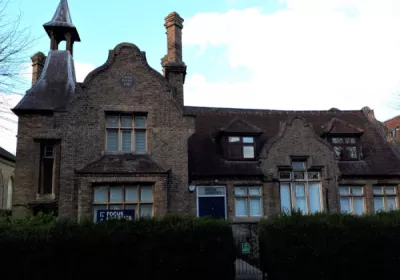
In the first few months of 2022 the Watford Observer carried a number of short pieces, prepared by the museum, on local people who had a considerable, but very varied, influence on the lives of our forebears – and indeed, ourselves. This Blog brings them all together, and expands what was published.
John White of Parsonage Farm
The first person in the series was the farmer, John White, born in June 1813. An arable farmer, he worked some of the land of Parsonage Farm, part of the ancient manor of Rickmansworth, on what is now Nightingale Road, Cedars Avenue and Townsfield. He shared it at first with his farmer father William, of the adjacent Appletree Farm towards Chorleywood (the tithe map confirms that they were there by 1839), but also had other holdings rented on his own account, and developed them over the years. By 1861 he was able to describe himself as farming 400 acres and employing 19 men and 8 boys – a sizeable holding for this area. He married Sophia Powell in 1841, and they had one child, Fanny, on who they clearly doted and who married William Hounsfield, one of the farm students, in 1865.
John White was a man of his time, with shooting and (especially) hunting important sports, but he and Sophia were heavily engaged with local causes: he was a churchwarden of St Mary’s for about fifty years, a ‘manager’ (similar to a governor) of the town’s National schools and a leader of the Penny Reading Society, while she founded and led the Lads’ Club and ‘clothing clubs’ related to the schools. They were local people of real significance, traveling quite freely by train to go to Watford and London as soon as the railway was available, otherwise by horse - indeed, Sophia had been badly injured by being thrown from a carriage in the 1850s, and was partly disabled as a result. Nonetheless, their golden wedding photograph shows them as a prosperous Victorian family. Sophia died in 1896, but John lived on to 1904.
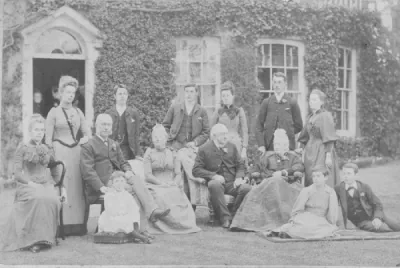
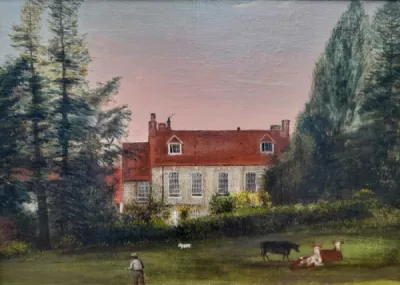
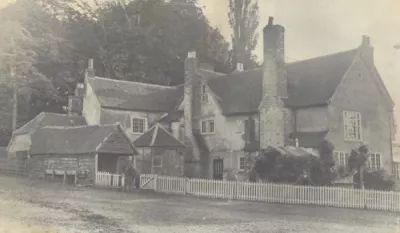
But for us, John White’s enduring legacy lies in his diaries, a wonderfully detailed account not only of his own life and work but also a deep insight into how people lived and worked round here. The diaries themselves were lost to us for many years: abstracts by the Watford local historian Kenneth Jones, who was also a friend of the family of John’s descendants, covering about five years appeared in the Rickmansworth Historical Society’s journal in 1970 and 1971, so we knew what was in them. But they were in the care of the family of William and Fanny Hounsfield, and we had no means of contacting them. But careful research and good luck has enabled us to contact the family, who in an act of extraordinary generosity have donated the whole set of diaries and accounts to the museum. We’re now working on how best to use them.
Tom Bevan
Tom Bevan was the head master of the Rickmansworth National Boys School. Born in Monmouthshire in 1869, he trained as a teacher before moving with his wife Kate to Rickmansworth in 1889 to take up a post at the School in the High Street. He became Headmaster and stayed until 1929, and many hundreds of local boys will have been taught by him.
He lived a pretty full life. Living in Nightingale Road, he played both cricket and hockey for Rickmansworth, and had a fine tenor voice, performing locally as well as arranging and conducting, especially for the Madrigal Society. He was also for a time, confusingly along with his namesake Thomas William Bevan of The Bury, a member of Rickmansworth Urban District Council, along with several others of the people featured in this post.

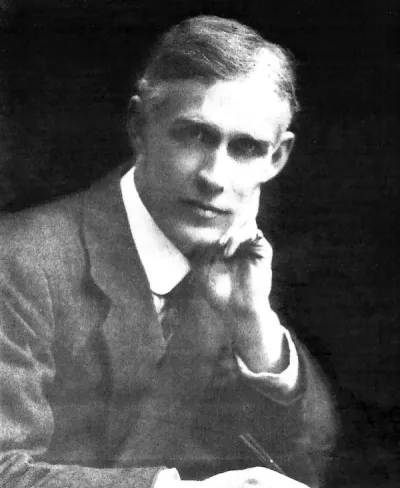
But Tom Bevan left a much larger legacy, as a historian and prolific writer. Using the pen-name ‘Walter Bamfylde’ for fiction for adults as well as his own for exciting stories for children set during momentous periods of English history or adventures set in various parts of the British Empire, he wrote over 40 books and many articles. He was, importantly for us, a historian, writing (for example) in 1925 for the Journal of the St Albans and Hertfordshire Archaeological and Architectural Society (SAHAAS - the Arc and Arc), and delivering at least one ‘magic lantern’ illustrated lecture in Rickmansworth in 1916, and his knowledge was reflected in his books. He was also the education editor for his publisher – all this while running a growing school and family! His daughter Marjorie, born in Rickmansworth in 1900, was also a writer of ‘school stories’ for girls, publishing nine.
Tom Bevan died in 1937. He deserves to be much better remembered, and hopefully this Blog post will help preserve his memory.
Stephen Beeson
One of the governors (as we would now call the 'foundation managers') of Bevan’s National School was Stephen Beeson. Born in 1845, the son of a baker at Chenies and trained as a plumber, he had a number of related skills including ‘bell hanger’, but when he set up his business in 1870 it was a hardware store. First in the High Street and then, from 1887, in Church Street, on the corner of Talbot Road in which he and his family lived at No 50, it grew to become a large homeware and hardware store, engineering business and builders.
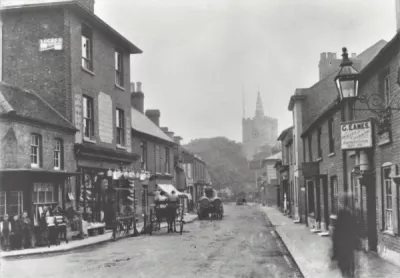
Like most of his contemporaries, Stephen played his full part in the life of the town. As well as his role in the Boys’ School he was a churchwarden of St Mary’s, an overseer of the poor in the Union Workhouse in Watford (he also held for a while the contract for the burials there) and an early active member of the town’s Voluntary Fire Brigade – he was followed by at least one of his sons.
The developing firm passed to the management of his sons, but not before the extended shop was offering in 1894 ‘furniture, bedsteads and bedding’ – ‘Beesons Yard’ in Bury Lane dates from about this time. As engineers they also supplied mechanisms to the American makers of the first revolving doors and for an undulating floor ‘amusement ride’, which brought them trans-Atlantic contacts - the breadth of the business was considerable and included the supply of sanitary ware (just as the new sewage system came to most of the houses of the area) as well as ironware fittings to the boatbuilders Walker Brothers.
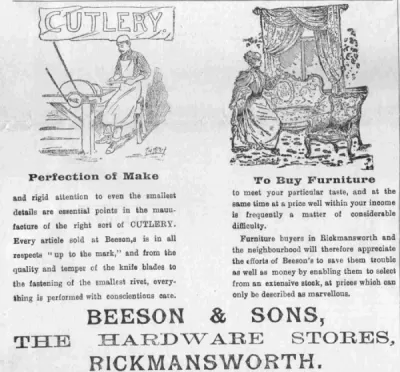
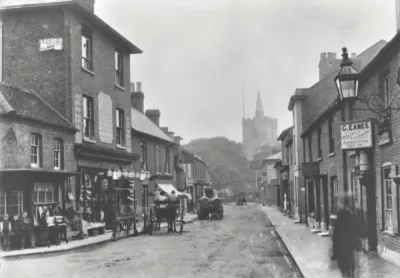
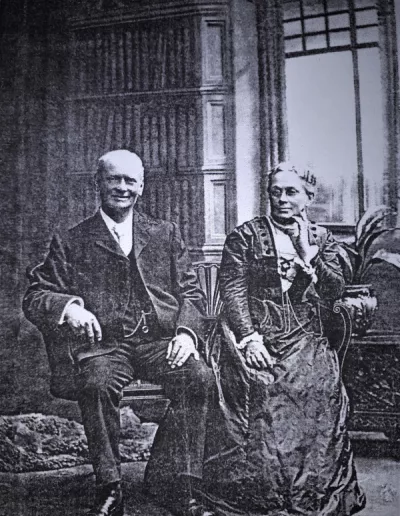
Stephen Beeson, who died in 1914, is a fine example of the local tradesman who established a simple business and then expanded it to become a significant supplier of a range of goods and serves to a wide area. The family (Stephen’s wife Mary played an important role in the firm) also shows how closely business people worked at that time: two of their daughters married brothers of Harry Walker, although not those involved in ‘Walker’s of Ricky’.
The firm declined in the 1960s and closed in 1970, but not before many local people had worked, and indeed been trained, there. Stephen Beeson’s name is well and fondly remembered.
Colin Taylor
Colin Taylor was born 1859 in Rickmansworth, the son of John and Sophie Taylor. John Taylor had moved to the Bury in about 1842, and had set up a bakery there in 1845, for which he had a short canal arm cut. So the family was reasonably well established in local business related to agriculture.
Colin was carefully prepared for life in business. He left school at seventeen, and was sent to work in an office in London to learn his business skills. By 1881, aged 22, he was already a corn merchant employing five men, having taken on his father’s business when John died (he is buried in St Mary's churchyard). He married Ann Wood in 1885, and on her early death in 1894 with two small children he re-married Fanny. They lived in Bury Lane while Colin developed his father’s business, becoming a coal and corn dealer on Batchworth Wharf, which also had other manufacturing shops including soap. As a coal merchant he had local offices across the area, including in Watford Lower High Street and in Bushey, Pinner and Northwood.
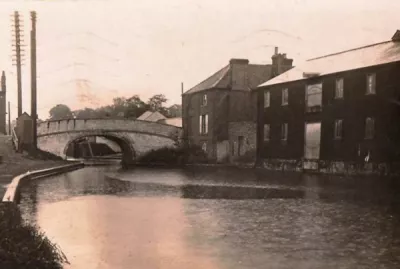
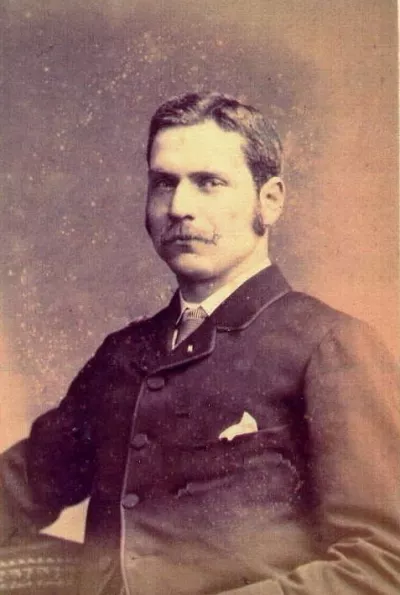
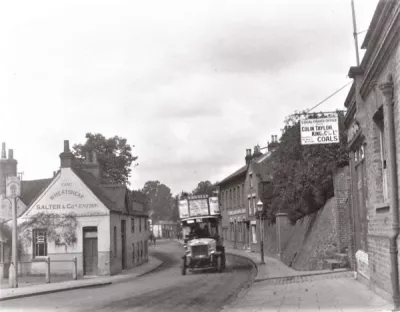
But it’s for his active interest in the town in which he had been born that we should remember him. He chaired the inaugural meeting of the Rickmansworth Traders’ Association in 1899 and, already a parish councillor, was elected to the first Rickmansworth Urban District Council in April 1898. In 1904 and 1905 he led the UDC in asking the County Council to limit the speed of cars in the urban district to ten mph, and also argued as a member of the highways committee that it was their duty to encourage building and assist anyone who wished to develop property (in 1903 he had himself had a dispute over the laying of the new sewers under his land). In 1906, the year he started a gymnastics club in the town, he became County Councillor for Rickmansworth, but remained most interested in local matters, remaining on the UDC with just a short break until his sudden death in March 1925. His son James had been killed in Flanders in 1915.
Colin Taylor is another fine example of the Victorian and Edwardian businessman who took the time and trouble to actively intervene in life in Rickmansworth.
Harry Walker - Walkers of Ricky
Rather later in time, but overlapping, was Harry Walker. Walker was born in 1881, the second of five sons and two daughters of Alfred, engineering supervisor for the Grand Junction Canal, and Sarah Walker, who moved to Lot Mead in 1885.
Harry was apprenticed to the wooden boat builders Bushells near Tring, and in June 1905 he leased the large Frogmoor Wharf at Batchworth from Lord Ebury. The lease allowed him to be a timber merchant and general merchant, and by September he was selling coal and coke as well as timber and builders’ supplies, and was docking boats for repair. He built boats for his own use from 1907 and for others from 1908, including one of the first ever oil-powered boats in 1911. The firm was an important customer for iron ware from Beesons.
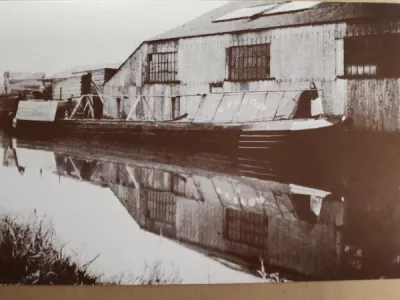
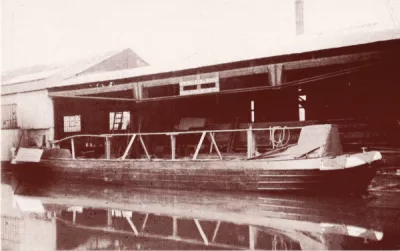
The full story of the business, which quickly included several of his brothers, is told in the book ‘Walkers of Ricky’. It went on to be a major local business, building boats and dealing in huge amounts of builders’ materials as well as coal, and taking on the Town Wharf as well. But it is his other activities, some of which still benefit the public, that we look at here.
The firm leased Batchworth Lake, from which they had already been extracting sand and gravel, in 1912, buying the freehold the next year with the intention of making it into ‘pleasure grounds’ and a boating lake, on which they also tested canal boats. Now the heart of the Aquadrome, it opened on August 3rd 1914, just as World War One was breaking out. Later, when Salter’s brewery closed in 1924, they bought the whole site, and between then and late 1928 they provided allotments and market facilities in which livestock were traded and auctions held. The market was not commercially viable and closed, but Harry remained involved with the Rickmansworth Picture House, built on part of the site in 1926, opening in 1927 and including a ballroom and an orchestra. It was a huge success, competing with and outlasting the Odeon along the High Street from 1936 to 1957, but it too closed in 1963.
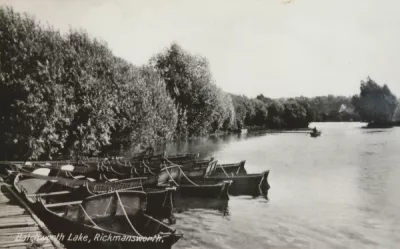
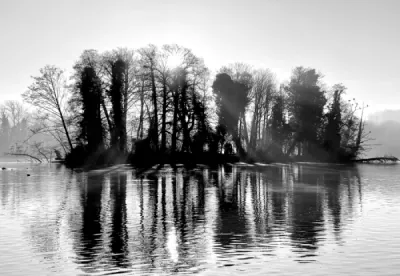
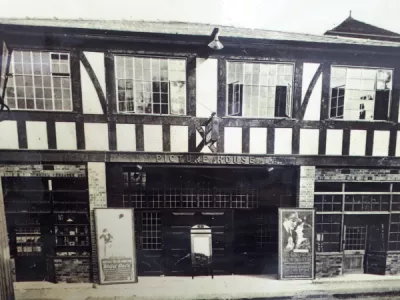
Harry Walker was involved in several other of the town’s business initiatives in the first half or the twentieth century, including the unsuccessful attempt to make a market hall in the old brewery premises after 1925. He married Doris in 1924, but they had no children: he died aged 68 in 1949, leaving behind not only a business which would endure for forty years more but also some of the well-loved facilities still in public ownership and care.
Amy Coster
Immediately after the First World War the sisters Amy and Ethel Coster opened their dressmaking and ladieswear business. They were daughters of Thomas Coster and his wife Ellen in a large Rickmansworth family. By 1911 their older sister, Ellen, was a young teacher at Parsonage Road school (the ‘girls’ department’ of the National School), Ethel, aged 17, was a dress maker’s assistant having been trained in Buckingham, while Amy, aged 15 and training as a book keeper, was a cashier.
In 1919 Amy and Ethel took a lease together on a shop in Rickmansworth at 70 High Street. ‘Costers’ was a dress makers and ladies’ outfitters, and the business saw Ethel upstairs making and altering clothes while Amy was in the shop and keeping the books. The address of both was officially that of the shop for a time.
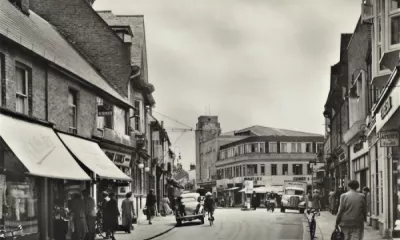
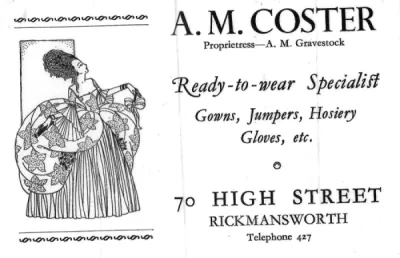
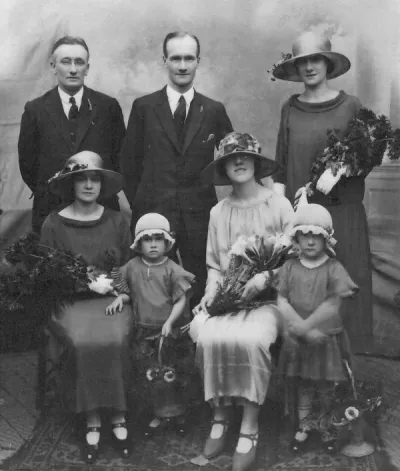
But Ethel married Charles Brackley in 1921; they lived in Northwood, and at some time a little later she left the business. Amy married Walter Gravestock, a railway employee, in the summer of 1924, and continued ‘Costers’ with significant success. They lived in the Cloisters, and their daughter joined her mother in the business in about 1951 (Amy’s brother Charles was also involved for a time). Amy retired in 1959, and the business closed. Amy Gravestock died in 1976, a well- respected lady.
Although there were other ladieswear shops in and around the town, Costers served a wide local area with a reputation for quality: the museum has many of the business’s records, yet to be analysed, but they confirm the wide range of Costers’ customers as well as what they bought. A number of local people worked for ‘Miss Coster’, as Amy continued to be known, and the museum would be very happy to hear from anyone with memories of A M Coster’s.
Edith Price Mayo - photographer and publican
Edith Price was born near Tottenham in 1879, the older of two daughters of Thomas and Elizabeth Price, who moved in the 1890s as a newsagent and tobacconist in Station Road, Rickmansworth. By 1901 she and her sister Florence seem to have lived ‘above the shop’, with their parents’ home higher up the road.
Like many young women of the day, she will have seemed ‘ordinary’, but she has left us with a photographic record of Rickmansworth between about 1900 and 1914 - and she also ran one of the best-known pubs of the town. In the spring of 1909 she married Thomas Mayo (1854-1927), the landlord of the White Bear at Batchworth who had been widowed probably in 1894. A member of the ‘Olde Fogies’, a group of businessmen who combined social life with supporting local good causes, he seems to have courted her for some years. They went on to have a daughter, Kathleen, in 1911, and a son, Thomas, in 1915: when her husband died Edith continued at the White Bear up to her own death in 1944.
But it is a photographer that Edith should be especially remembered. At a time when photography needed time and dedication she seems to have taken a number of the images now, thanks to her daughter Mrs Kathleen Bowen, in the museum’s collection and featured in the book published by the museum’s founder, Eddie Parrott, in 1996. And so we have a local record of the Coronations of 1902 and 1911, of the White Bear and other scenes of the town such as the laying of the sewers, which would otherwise have been lost. Local historians are in her debt – and hope that others are now following her lead.
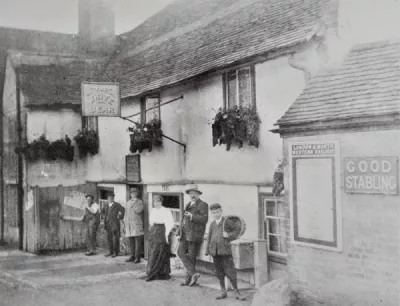
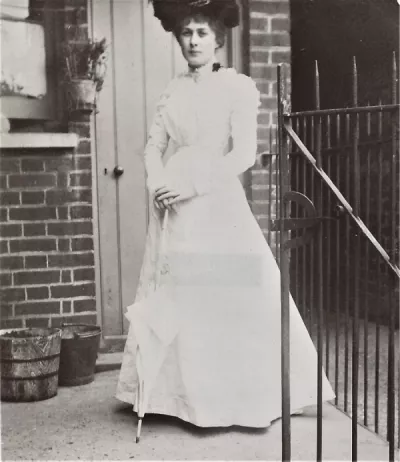
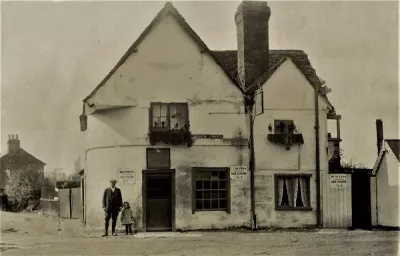
Henry 'Neggy' Wilson
'Neggy' Wilson was a great figure in Croxley Green. From 1901 Henry Thomas Wilson ran the National Boy’s School, and he and Tom Bevan will have inevitably have worked closely behind the scenes. He was born in north Kent in 1870, the fifth of a family of nine children. A professional teacher, he became Head Teacher of a school in Hendon in his late twenties, but came to Croxley Green as a visitor and liked it. Finding that the headship of the Croxley Green National (boys’) School was vacant, he applied for and got it, and his time there made him a figure of renown. The origins of the universal nickname ‘Neggy’ are wholly unknown, but it defined the man for generations of his pupils. Mr Wilson was one of Croxley Green’s most influential personalities in the first years of the twentieth century, and is fondly remembered to this day.
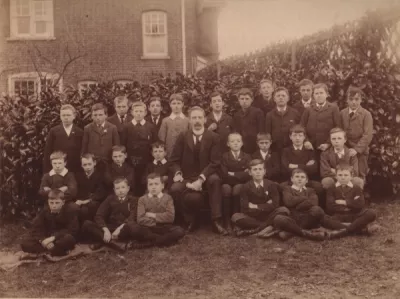
‘Neggy’ Wilson never married, but at least one of his sisters lived with him in New Road, Yorke Road and on the Green for most of the rest of his life. He came almost by accident, visiting Croxley Green in the summer of 1901: finding the headship of the National School in Watford Road, next to what became the Duke of York pub, vacant, he applied for and got the job. He made his mark at once: he insisted on correct diction and grammar, played the piano for singing lessons – and knew at once if someone was missing from a group of boys. Tall and slight of build, he was incensed by unfair or thoughtless behaviour, and used the cane when he had to. But one of his pupils recollected over thirty years later that "he was a great master – done a lot for us boys … he bought everything - stumps, bats, pads – and the same with football". Sport was as important to him as the arts: he would take groups of boys to Lords or to the Old Vic, and got permission to use the northern part of the Green as a cricket field which he then levelled and rolled himself.
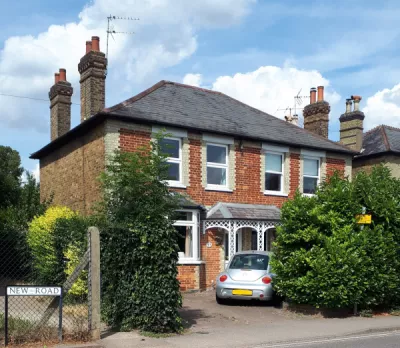
He said that he’d never played a game of football, but he happily refereed so that the boys would be able to play. He was chairman of the cricket club, founded the Croxley Green Society, conducted the church choir, wrote the basic script for the Croxley Mummers still used today and set in hand the Croxley Green War Memorial. It was said with good reason that Croxley Green was run at this time by the doctor, the vicar, the mill manager and the school master, and they certainly worked closely together (although not always harmoniously) in many initiatives.
‘Neggy’ Wilson retired from teaching in 1934, but continued prominently in the village. His pupils continued to visit him until the very end of his life in 1952: he was, one said later, ‘an extraordinary man’.
Dr Roderick Henderson - fire fighter, GP and magistrate
Another very prominent man, well known to all the other people in this piece, was Roderick Henderson. Born in London in 1841, he became a medical student at Guys Hospital in 1860. He married Maria French in 1866 (their two sons and a daughter were all born in Rickmansworth), after he had moved to Rickmansworth in 1865 to take up the medical practice in the town. Initially living at 191 High Street, they moved to Basing House after a few years: in the 1881 Census he was described simply as ‘General Practitioner’, but in 1891 he was a JP as well as ‘Surgeon’. As the local doctor he oversaw the health of the children (both boys and girls) of the National Schools in Rickmansworth, and was also the medical officer for the Watford Workhouse.
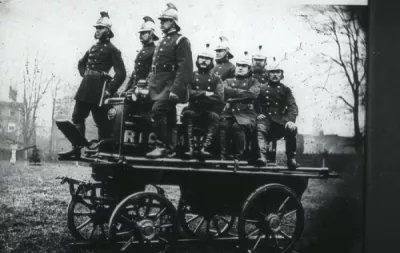
But Dr Henderson’s main claim to fame nowadays relates to his role in modernising the ancient parish fire brigade. He had become interested in volunteer firefighting while a medical student in London in the 1860s, and took part in several large actions. Almost on his arrival a fire in the High Street was attended by the old parish fire pump with a group of onlookers helping as best they could, but with limited effect. He suggested to the parish that a properly trained body of men with a sound knowledge of their equipment, and able to maintain it properly, be recruited to fight fires quickly and efficiently. A meeting in the town hall resolved that a Fire Brigade should indeed be formed, paid for by public subscription; and his interest in and knowledge of the matter made Dr Henderson the obvious choice to form and train the newly-formed brigade. The first ‘Captain’ was Herbert Fellows, the manager of Salters Brewery: the old parish fire pump was handed over and housed in a new building (paid for by Mr Fellows) in Church Street, opposite the church, as was reported in the Watford Observer in late 1870. Henderson became Captain a few years later, and was responsible for the provision of the new fire station, and a new horse-drawn engine (seen in the photo), in 1891. He continued to lead, and support financially, the fire brigade until it was taken over by the UDC in 1925, when he was 84.
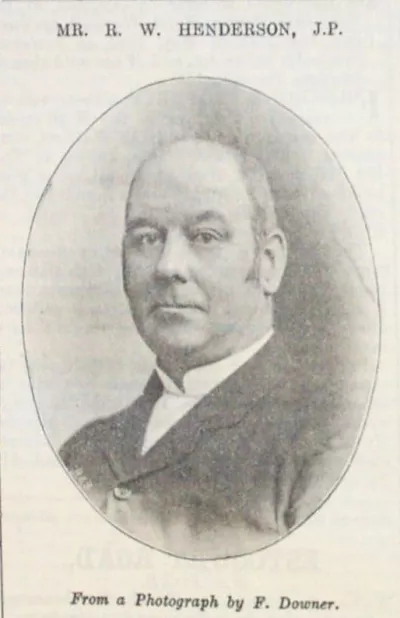
But he did much more. Reputed (we have no real evidence) to have owned the first motor-car in the town, he was also a magistrate for over twenty years, and was responsible for the removal in 1912 of the licences of twelve premises in Rickmansworth, including the Bell inn, which he somehow ended up owning. He was President of the cricket club, a major shareholder in and last Chairman of the Town Hall Company, and served for many years as Churchwarden of St Mary’s, taking an active part in its rebuilding in the 1880s, a duty he shared with John White.
Maria died in 1919, but the doctor remarried Muriel Woodward and remained in the town until his death in 1929. His funeral was conducted with some pomp: his coffin was preceded by the new fire engine. He had been central to much of the life of the town for sixty years, and is remembered with great respect – we have a display commemorating him and his work in the museum.
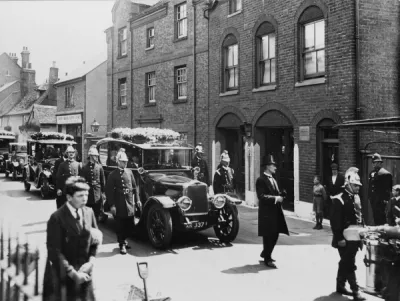
May Barton Smith
We observed earlier that Croxley Green was in many respects 'run' by the school master, the vicar, the doctor and the manager of Dickinson's Croxley Mill as the biggest employer in the area. The mill manager around the turn of the century was Charles Barton Smith, a significant and influential figure in his own right - he was also the chairman of Rickmansworth Urban District Council for a number of years - but our blog post closes with a sketch of his daughter, May.
Mary Evaline Barton Smith (May) was born in 1882, and never married: she lived with her parents in Croxley Green at Lindiswara, the mill manager’s house, until his death in 1929, and then at no 7, Dickinson Avenue (“Marden”), staying there with her mother and siblings (only their brother Frank seems to have married). She died in 1948, at the age of 65.
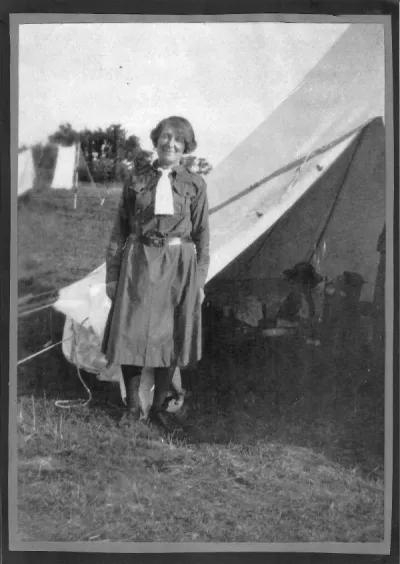
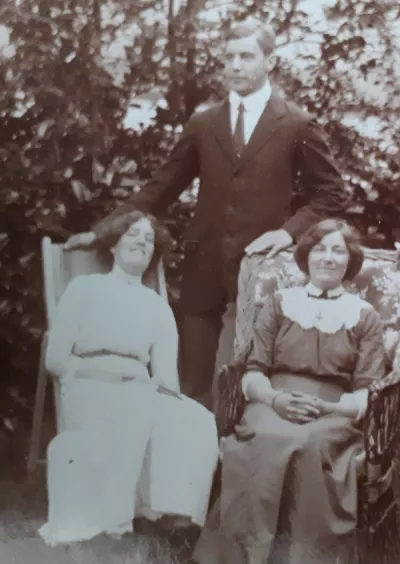
This apparently ordinary life belies a great deal of lifelong work for young people, especially for girls through the Girl Guides, but also in local organisations. She set up the first Guide Company in 1913, about three years after the movement was formed by Baden-Powell, and was both Captain and secretary of it. They met at the Dickinson’s Institute on Tuesdays and Fridays, and some idea of the imagination she applied to it comes from items in the Watford Observer: in June 1914 they arranged ‘entertainment’ at the Institute with the help of several soldiers, and in 1915 they put on a play at the annual Mill staff children’s party: it wasn’t all camping and cooking. She set up the Brownies in 1925.
She was a Red Cross Volunteer through the First World War from early 1916, serving as Quartermaster (logistics coordinator) in the Voluntary Aid Detachment at the Croxley Green Hospital which took over the Institute at that time. She was also a founder member, and Treasurer, of the Croxley Green Society when it was set up in 1938, and of course the Girl Guides were affiliated to it – as was the Croxley Green District Nursing Association, of which she was also (joint) Hon Secretary.
On the outbreak of WW2 May was leading a Guide Camp on the south coast, and had to get the girls home while applying the new blackout regulations, and she continued to run Guides through the War without differentiating the ages too closely, no doubt to make sure that everyone could be occupied. May Barton Smith instilled the disciplines of Guiding in a large number of young women, and is still remembered for it.